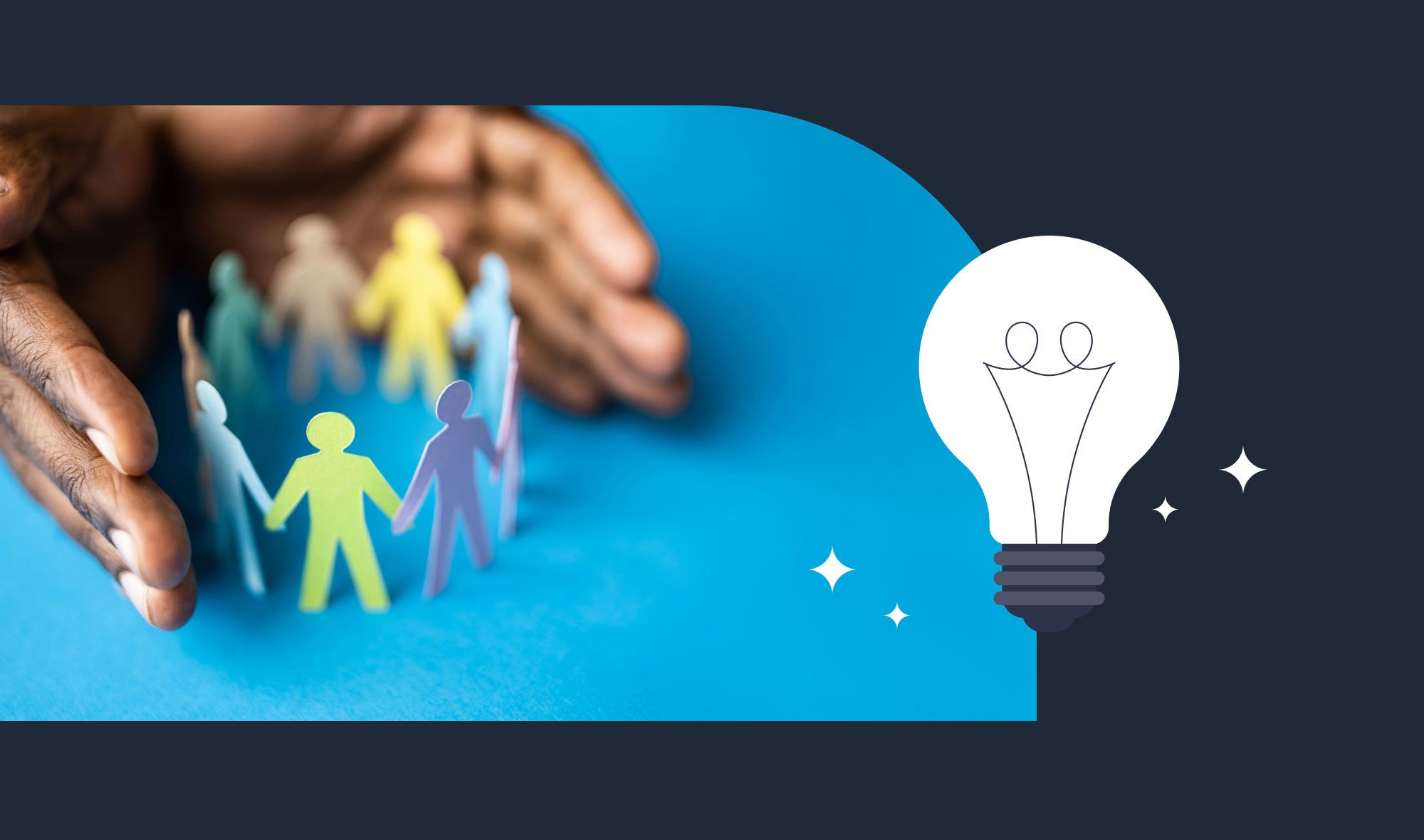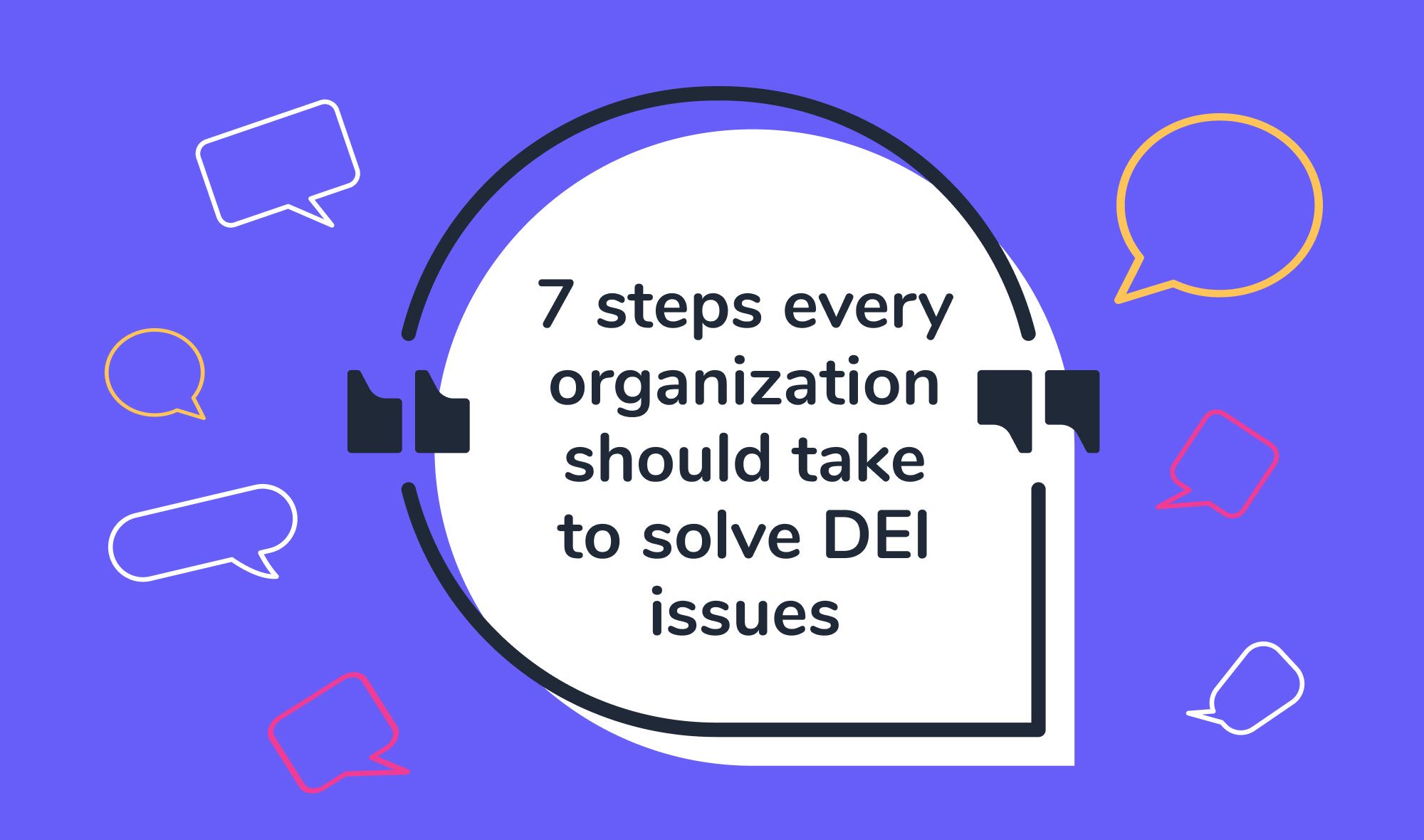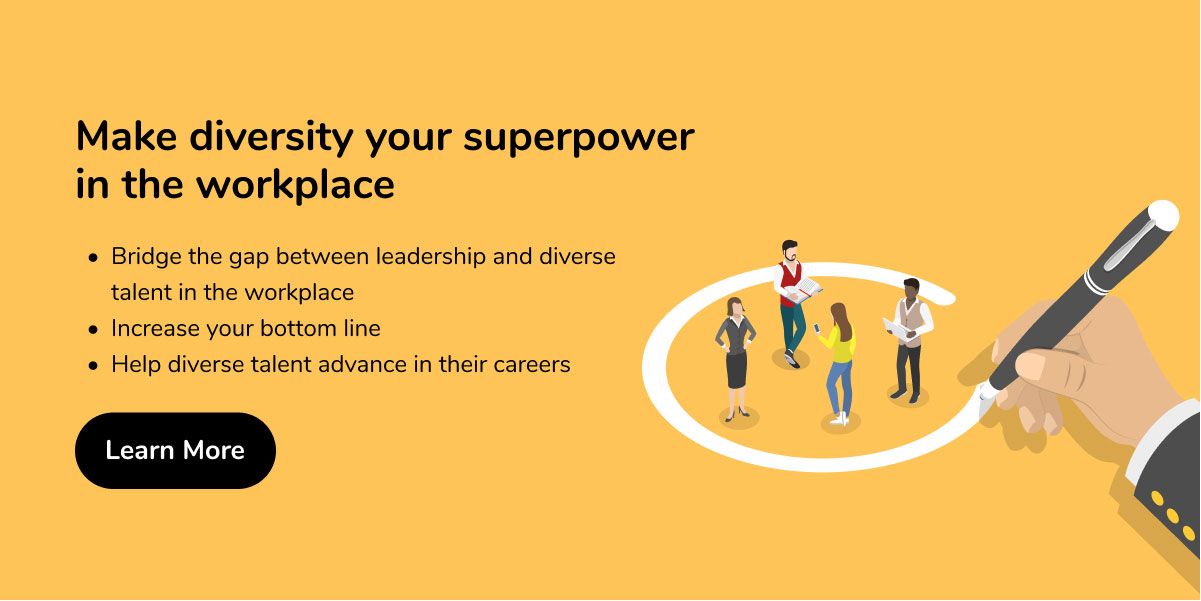7 powerful ways to take action on DEI (diversity, equity and inclusion)
By Julian Lewis • February 2, 2023

Diversity, equity, and inclusion (DEI) have become popular topics of conversation in recent years for a number of reasons. Due to increased awareness of systematic discrimination and bias, demographic changes in the workforce, and increased visibility of DEI issues in the media, many companies have been reviewing their business strategy and making adjustments to foster a more inclusive environment.
Studies have shown that organizations with diverse and inclusive cultures tend to be more innovative, perform better financially, and have higher employee satisfaction and retention rates. This has led more companies and organizations to make DEI training a priority and to invest in initiatives to improve diversity and inclusion within their workforce.
In this guide, we will explore 7 powerful ways to take action on DEI. From educating ourselves to implementing policies and practices, these strategies can help create a more inclusive and equitable environment for all.
Whether you are an individual, a leader of a company, or a member of a community, there are steps you can take to make a difference. So let's dive in and discover how we can take action in increasing diversity, equity, and inclusion today.
What does DEI stand for?

Diversity, equity, and inclusion (DEI) are important topics in today's society, and taking action to promote them can have a positive impact on individuals, organizations, and communities. But what exactly does that mean?
First, let's break down the definition of each area of diversity, equity, and inclusion:
What is workplace diversity?
Workplace diversity refers to the variety of differences among people in an organization, including but not limited to differences in race, ethnicity, national origin, gender, age, sexual orientation, physical abilities, political perspective, religious beliefs, educational background, and socioeconomic status.
Defining diversity can also include differences in communication styles, personality, and problem-solving approaches. The goal of workplace diversity is to create an inclusive environment where all employees feel valued, respected, and able to reach their full potential.
What is workplace equity?
Workplace equity describes fair treatment, access, opportunity, and advancement for all employees, regardless of their individual differences, such as physical ability, religious affiliations, or sexual orientation. This includes ensuring that policies, practices, and decision-making processes in a work environment are free from discrimination and bias and that they promote fairness and justice for diverse groups. It also means that employees have equal access to opportunities, resources, and rewards and that they are held to the same standards of performance and behavior.
Workplace equity also includes addressing systemic issues that may create barriers for certain groups of employees, such as underrepresentation, lack of representation in leadership roles, and other outcome disparities. It also means actively working to eliminate the barriers that prevent certain individuals from reaching their full potential.
What is workplace inclusion?
Inclusion means that all employees are treated with dignity and respect and that their differences are recognized and valued. It also means that the employer proactively creates a sense of collaboration and frequent opportunities for employees to connect and learn from one another, regardless of their background or characteristics.
In practice, workplace inclusion involves actively creating an environment where all employees feel welcome, respected, and valued (check out Building a better business: how to identify and correct negative workplace culture for more on this topic). This includes creating a culture of open communication, active listening, and mutual respect. It also means being proactive in recruiting, hiring, and promoting diverse employees from underrepresented groups and creating opportunities for professional development and leadership.
In addition, it means providing accommodations for employees with disabilities and being sensitive to the needs of employees with diverse socioeconomic status and cultural backgrounds and practices.
The benefits of DEI in the workplace

It's no secret that senior leaders who embrace diversity and prioritize equity and inclusion efforts have reaped countless benefits in the workplace. A diverse and inclusive workforce brings different perspectives, ideas, and experiences, which can ultimately lead to a more successful and sustainable company culture.
Improved employee engagement and retention
Employees that feel like they are part of a team and that their contributions are valued will be more engaged in their work. When employees are engaged, they are more likely to be committed to the organization, to have a sense of ownership of their work, and to be motivated to stay with the organization.
Moreover, diversity, equity, and inclusion initiatives that provide equal opportunities for professional development, growth, and advancement, can also lead to improved employee engagement and retention. When employees have opportunities to learn and grow, they are more likely to feel satisfied with their careers and motivated to buy into the company's mission with full participation.

Increased creativity and innovation
When people from different backgrounds, cultures, and experiences work together, they bring a variety of new perspectives and ideas to the table. This can lead to a more robust and creative problem-solving process, as well as a more innovative approach to finding solutions. A diverse workforce can also lead to new and innovative ideas being generated from diverse perspectives and experiences, which can benefit the organization in the long run.
Additionally, when employees from minority groups are included and have equal opportunities for leadership, they are more likely to contribute their unique perspectives and ideas. This can lead to a work environment with more creativity and better decision-making.
Enhanced reputation and market share
Companies that prioritize diversity, equity, and inclusion are often viewed more favorably by customers, clients, and other stakeholders, which can lead to increased market share and a stronger reputation. One reason is that consumers are becoming more aware of the importance of DEI and are more likely to support companies that align with their values.
Additionally, a company that is seen as inclusive and respectful of diverse customers and employees is more likely to attract and retain customers from diverse backgrounds, which can lead to increased market share.
Many investors and other stakeholders are increasingly interested in companies that prioritize DEI as well, as they see it as an important factor that signals a responsible and sustainable business. By prioritizing DEI, companies can attract new investors and stakeholders, which can lead to increased market share and a stronger reputation.
7 steps every organization should take to solve DEI issues

Despite the increased attention and awareness of DEI (Diversity, Equity, and Inclusion) issues in recent years, there is still a lot of work to be done in order to create truly equitable playing fields and inclusive environments.
One of the main challenges is that DEI is a complex and multifaceted issue, and addressing it requires a comprehensive approach. Additionally, DEI initiatives often focus on addressing the symptoms rather than the root causes of inequality.
DEI work needs to go beyond "checking the box" and be more than just policies and procedures. It requires meaningful action and a cultural shift that embeds diversity, equity, and inclusion values and practices into the organization's DNA. However, it can be difficult to know where to start.
Whether you are just beginning to introduce diversity initiatives into your company's culture, or you are looking to improve on existing equal opportunity practices, here are 7 steps that every employer should take to create, build, and nurture diverse teams.
Look at your hiring process
The first step in solving DEI issues is to examine your hiring process. This includes looking at where you are advertising job openings, the language used in job postings, and the qualifications required for different positions. It also includes assessing your recruitment and selection process, as well as the composition of your hiring teams.
There are a variety of resources available to help organizations assess their hiring and selection process and solve underlying DEI issues. The Society for Human Resource Management (SHRM), for example, offers a variety of resources, including guides and templates, to help organizations assess their hiring and selection process and develop strategies to improve DEI. The Center for Talent Innovation (CTI) is another research and consulting organization that offers a variety of resources, including a toolkit for assessing and addressing unconscious bias as it pertains to job seekers during the recruiting process.
By taking a critical look at how you hire, you can identify any potential biases and make changes to create a more inclusive and equitable process.
Dig into your data
Another important step is to analyze your data. This includes looking at the demographic makeup of your workforce, as well as the representation of different groups in leadership roles.
Be on the lookout for trends, such as pay disparities and high turnover among certain groups of employees, as these could be indicative of DEI issues. By analyzing your data, you can identify any disparities and take steps to address them.
Incorporate intentional (and extended) onboarding programs
Once you have a diverse and inclusive workforce, it’s important to ensure that employees feel welcome, respected and valued. One way to do this is through intentional onboarding programs. These programs should be designed to help new employees understand the culture and values of the organization, as well as provide them with the tools they need to be successful.
Employees should receive training on cultural competency, which includes understanding and respecting the different backgrounds, cultures, and perspectives of their colleagues. This can include training on unconscious bias, microaggressions, and effective communication across cultures.
Employees should also receive education on the importance of diversity and inclusion and the organization’s specific DEI initiatives. This can include training on the history and current state of diversity and inclusion in the workplace, as well as the business case for diversity and inclusion.
Avoid the ‘minority tax'
The ‘minority tax’ refers to the additional burdens and responsibilities that are often placed on individuals from underrepresented groups.
For example, minority employees may be expected to speak on behalf of their entire group, or to be the only representative of their group in meetings and discussions. This can be overwhelming and can take away from the employee's ability to focus on their own work.
To avoid the ‘minority tax,’ organizations should ensure that all employees are held to the same standards of performance and behavior and that everyone has access to the same opportunities and resources.
Align ERGs with leadership sponsors
An Employee Resource Group (ERG) is a group of employees who come together voluntarily to promote and support a specific aspect of diversity and inclusion within an organization. ERGs are typically organized around common characteristics or experiences, such as race, gender, sexual orientation, or disability. They can also be organized around other aspects such as veterans, working parents, and so on.
These groups are typically employee-led and provide networking opportunities for employees to connect with one another, share experiences, and work together to address issues related to diversity and inclusion within the organization. They can also serve as a way for employees to provide feedback to leadership, and to propose and implement initiatives related to diversity and inclusion.
Employee Resource Groups can be an effective way to promote DEI, but they are most effective when they are aligned with leadership sponsors. Leadership sponsors can help ERGs to connect with the broader organization, and they can also help to ensure that ERGs are aligned with the organization’s overall DEI goals.
Open up lines of communication
Open lines of communication are essential for solving DEI issues. This includes designing a safe space for employees to share their experiences, concerns, and ideas. It also includes providing regular DEI training and education on various topics, as well as encouraging open dialogue and feedback.
By creating an inclusive culture of transparency and open communication, organizations can develop a deeper understanding of DEI issues and work towards solutions together.
Make DEI part of your company's DNA
Finally, it’s important to make DEI an integral part of your company’s culture and values. This means embedding DEI initiatives and practices into the organization’s DNA and making it a priority at all levels of the organization. This includes involving all employees in DEI efforts, setting measurable goals, and holding leaders accountable for progress.
A business coach can help make diversity, equity, and inclusion a part of a company's DNA by providing guidance and support in several ways. By working with the organization to assess the current state of inclusion, and identifying areas of strength and areas for improvement, the coach can help to establish clear goals and objectives, communication expectations, administer training and education on DEI topics, and create opportunities for employees to provide feedback and get involved.
Conclusion
Tackling equity issues requires a comprehensive approach and commitment from all levels of the organization. By examining current processes and data, identifying where and how the workplace requires improvement, and having meaningful conversations surrounding diversity gaps and potential solutions, organizations can take meaningful steps toward constructing a more equitable and inclusive workplace.
These steps are not a one-time solution, but rather a continuous process that requires ongoing review and evaluation, as well as organizational accountability, to assess progress and make adjustments as needed. It's also important to keep in mind that DEI is not only a moral and social responsibility, but it's also an essential business strategy. By taking action on DEI today, organizations can create a more equitable and inclusive workplace for all employees, and ultimately, drive business success.
To learn more about personal growth and self-discovery, check out these top 10 Shadow Work books recommended by experts.

Read more about: Executive Coaching
About Julian Lewis
Julian Lewis is a driven and accomplished professional with a passion for driving positive change in the business world. He is the co-founder and COO at Zella Life.
His own experience as a professional of color in a Fortune 500 company led him to discover the limitations for advancement that many professionals like himself face. Determined to reach his full potential, Julian became an established business coach and entrepreneur, committed to supporting others in their pursuit of personal and professional growth.
Today, Julian is a recognized corporate trainer, coach, and leader, known for his ability to leverage real-life experiences and evidence-based methodologies to affect positive change within individuals and organizations. As the leader of Zella Life's coaching division, he is dedicated to empowering individuals and businesses to achieve their full potential.